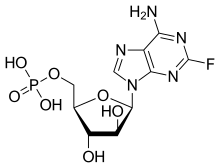Fludarabine
Fludarabine, sold under the brand name Fludara among others, is a chemotherapy medication used in the treatment of leukemia and lymphoma.[1] These include chronic lymphocytic leukemia, non-Hodgkin's lymphoma, acute myeloid leukemia, and acute lymphocytic leukemia.[1] It is given by injection into a vein or by mouth.[1][2]
 | |
| Clinical data | |
|---|---|
| Trade names | Fludara, others |
| AHFS/Drugs.com | Monograph |
| MedlinePlus | a692003 |
| Pregnancy category |
|
| Routes of administration | intravenous, by mouth |
| ATC code | |
| Legal status | |
| Legal status |
|
| Pharmacokinetic data | |
| Bioavailability | 55% |
| Protein binding | 19 to 29% |
| Elimination half-life | 20 hours |
| Excretion | kidney |
| Identifiers | |
IUPAC name
| |
| CAS Number | |
| PubChem CID | |
| IUPHAR/BPS | |
| DrugBank | |
| ChemSpider | |
| UNII | |
| KEGG | |
| ChEBI | |
| ChEMBL | |
| CompTox Dashboard (EPA) | |
| ECHA InfoCard | 100.123.703 |
| Chemical and physical data | |
| Formula | C10H13FN5O7P |
| Molar mass | 365.212 g/mol g·mol−1 |
| 3D model (JSmol) | |
SMILES
| |
InChI
| |
| | |
Common side effects include nausea, diarrhea, fever, rash, shortness of breath, numbness, vision changes, and feeling tired.[1] Severe side effects include brain dysfunction, low blood cell counts, and lung inflammation.[1] Use in pregnancy will likely result in harm to the baby.[1] Fludarabine is in the purine analog family of medications and works by interfering with the duplication of DNA.[1][3]
Fludarabine was approved for medical use in the United States in 1991.[1] It is on the World Health Organization's List of Essential Medicines, the most effective and safe medicines needed in a health system.[4] The wholesale cost in the developing world is about US$54.00 per 50 mg vial.[5] In the United Kingdom it costs about 155.00 pounds per 50 mg vial.[2]
Medical uses
Fludarabine is highly effective in the treatment of chronic lymphocytic leukemia, producing higher response rates than alkylating agents such as chlorambucil alone.[6] Fludarabine is used in various combinations with cyclophosphamide, mitoxantrone, dexamethasone and rituximab in the treatment of indolent non-Hodgkin's lymphomas. As part of the FLAG or FLAMSA regimen, fludarabine is used together with cytarabine and granulocyte colony-stimulating factor in the treatment of acute myeloid leukaemia. Because of its immunosuppressive effects, fludarabine is also used in some conditioning regimens prior to allogeneic stem cell transplant.
Side effects
Fludarabine is associated with profound lymphopenia, and as a consequence, increases the risk of opportunistic infections. People who have been treated with fludarabine will usually be asked to take co-trimoxazole or to use monthly nebulised pentamidine to prevent Pneumocystis jiroveci pneumonia. The profound lymphopenia caused by fludarabine renders patients susceptible to transfusion-associated graft versus host disease, an oftentimes fatal complication of blood transfusion. For this reason, all patients who have ever received fludarabine should only be given irradiated blood components.
Fludarabine causes anemia, thrombocytopenia and neutropenia, requiring regular blood count monitoring. Some patients require blood and platelet transfusion, or G-CSF injections to boost neutrophil counts.
Fludarabine is associated with the development of severe autoimmune hemolytic anemia in a proportion of patients.[7]
Difficulties are often encountered when harvesting peripheral blood stem cells from patients previously treated with fludarabine.[8]
Pharmacology
Fludarabine is a purine analog, and can be given both orally and intravenously. Fludarabine inhibits DNA synthesis by interfering with ribonucleotide reductase and DNA polymerase. It is active against both dividing and resting cells. Being phosphorylated, fludarabine is ionized at physiologic pH and is effectually trapped in blood. This provides some level of specificity for blood cells, both cancerous and healthy.
History
Fludarabine was produced by John Montgomery and Kathleen Hewson of the Southern Research Institute in 1968.[9]
Names
It is generally used as its phosphate salt known as fludarabine phosphate.
References
- "Fludarabine Phosphate". The American Society of Health-System Pharmacists. Archived from the original on 21 December 2016. Retrieved 8 December 2016.
- British national formulary : BNF 69 (69 ed.). British Medical Association. 2015. p. 590. ISBN 9780857111562.
- Helms, Richard A.; Quan, David J. (2006). Textbook of Therapeutics: Drug and Disease Management. Lippincott Williams & Wilkins. p. 2309. ISBN 9780781757348. Archived from the original on 2016-12-20.
- "WHO Model List of Essential Medicines (19th List)" (PDF). World Health Organization. April 2015. Archived (PDF) from the original on 13 December 2016. Retrieved 8 December 2016.
- "Fludarabine Phosphate". International Drug Price Indicator Guide. Retrieved 8 December 2016.
- Rai KR; et al. (2000). "Fludarabine compared with chlorambucil as primary therapy for chronic lymphocytic leukemia". N Engl J Med. 343: 1750–7. doi:10.1056/NEJM200012143432402. PMID 11114313.
- Gonzalez H, Leblond V, Azar N, et al. (June 1998). "Severe autoimmune hemolytic anemia in eight patients treated with fludarabine". Hematol Cell Ther. 40: 113–8. PMID 9698219.
- Tournilhac O; et al. (2004). "Impact of frontline fludarabine and cyclophosphamide combined treatment on peripheral blood stem cell mobilization in B-cell chronic lymphocytic leukemia". Blood. 103: 363–5. doi:10.1182/blood-2003-05-1449. PMID 12969985.
- Sneader, Walter (2005). Drug discovery: a history. New York: Wiley. p. 258. ISBN 0-471-89979-8.